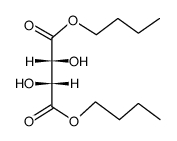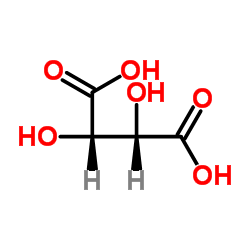87-92-3
| 中文名 | L-酒石酸二丁酯 |
|---|---|
| 英文名 | (2R,3R)-Dibutyl 2,3-dihydroxysuccinate |
| 中文别名 | L-(+)-酒石酸二丁酯 |
| 英文别名 |
L-(+)-TARTARIC ACID DI-N-BUTYL ESTER
DIBUTYL TARTRATE Dibutyl L-(+)-tartrate DIBUTYL D-TARTRATE (+)-DIBUTYL-L-TARTRATE Dibutyl L-tartrate EINECS 201-784-9 MFCD00009443 L-(+)-TARTARIC ACID DIBUTYL ESTER |
| 密度 | 1.09 |
|---|---|
| 沸点 | 182 °C (11 mmHg) |
| 熔点 | 20-22 °C |
| 分子式 | C12H22O6 |
| 分子量 | 262.29900 |
| 闪点 | 167 °C |
| 精确质量 | 262.14200 |
| PSA | 93.06000 |
| LogP | 0.39480 |
| 外观性状 | 透明无色至淡黄色液体在熔点后 |
| 折射率 | 1.446-1.448 |
| 储存条件 | 密封贮藏,储存在阴凉、干燥的地方。 |
| 稳定性 | 与强氧化剂反应。为可燃性物质,注意火源。化学性质较不稳定,有水存在时常温即发生水解,游离出酒石酸。 |
| 分子结构 | 1、摩尔折射率:64.18 2、摩尔体积(cm3/mol):229.3 3、等张比容(90.2K):587.2 4、表面张力(dyne/cm):42.9 5、极化率(10-24cm3):25.44 |
| 计算化学 | 1、 疏水参数计算参考值(XlogP):1.5 2、 氢键供体数量:2 3、 氢键受体数量:6 4、 可旋转化学键数量:11 5、 互变异构体数量: 6、 拓扑分子极性表面积(TPSA):93.1 7、 重原子数量:18 8、 表面电荷:0 9、 复杂度:227 10、同位素原子数量:0 11、确定原子立构中心数量:2 12、不确定原子立构中心数量:0 13、确定化学键立构中心数量:0 14、不确定化学键立构中心数量:0 15、共价键单元数量:1 |
| 更多 | 1. 性状:纯品为白色晶体,多数为无色或淡黄色液体。 2. 相对密度(g/mL,25/4℃):1.086 3. 相对蒸汽密度(g/mL,空气=1):未确定 4. 熔点(ºC):21 5. 沸点(ºC,常压):312 6. 黏度(mPa·s,18ºC):10.59 7. 折射率(20ºC):1.4463 8. 闪点(ºC,开口):91 9. 闪点(ºC,闭口):132 10. 自燃点或引燃温度(ºC):未确定 11. 蒸气压(kPa,175ºC):0.67 12. 蒸气压(kPa,186ºC):1.87 13. 燃烧热(KJ/mol):未确定 14. 临界温度(ºC):未确定 15. 临界压力(KPa):未确定 16. 油水(辛醇/水)分配系数的对数值:未确定 17. 爆炸上限(%,V/V):未确定 18. 爆炸下限(%,V/V):未确定 19. 溶解性:能与醇、醚、氯仿、苯等多种有机溶剂混溶。能溶解氯化橡胶、松香、乳香、虫胶、甘油三松香酸酯、硝酸纤维素、石蜡油、聚氯代乙酸乙烯酯等。25℃时在水中溶解1%;水在酒石酸二丁酯中溶解4%。 |
Synonym:None Section 2 - COMPOSITION, INFORMATION ON INGREDIENTS
Risk Phrases: None Listed. Section 3 - HAZARDS IDENTIFICATION EMERGENCY OVERVIEW
The toxicological properties of this material have not been fully investigated. Potential Health Effects Eye: May cause eye irritation. The toxicological properties of this material have not been fully investigated. Skin: May cause skin irritation. The toxicological properties of this material have not been fully investigated. Ingestion: May cause irritation of the digestive tract. The toxicological properties of this substance have not been fully investigated. Inhalation: May cause respiratory tract irritation. The toxicological properties of this substance have not been fully investigated. Chronic: No information found. Section 4 - FIRST AID MEASURES Eyes: Flush eyes with plenty of water for at least 15 minutes, occasionally lifting the upper and lower eyelids. Get medical aid. Skin: Get medical aid. Flush skin with plenty of water for at least 15 minutes while removing contaminated clothing and shoes. Wash clothing before reuse. Ingestion: Never give anything by mouth to an unconscious person. Get medical aid. Do NOT induce vomiting. If conscious and alert, rinse mouth and drink 2-4 cupfuls of milk or water. Inhalation: Remove from exposure and move to fresh air immediately. If not breathing, give artificial respiration. If breathing is difficult, give oxygen. Get medical aid. Notes to Physician: Section 5 - FIRE FIGHTING MEASURES General Information: As in any fire, wear a self-contained breathing apparatus in pressure-demand, MSHA/NIOSH (approved or equivalent), and full protective gear. During a fire, irritating and highly toxic gases may be generated by thermal decomposition or combustion. Use water spray to keep fire-exposed containers cool. Vapors may be heavier than air. They can spread along the ground and collect in low or confined areas. Containers may explode when heated. Extinguishing Media: Use agent most appropriate to extinguish fire. Cool containers with flooding quantities of water until well after fire is out. Use water spray, dry chemical, carbon dioxide, or appropriate foam. Section 6 - ACCIDENTAL RELEASE MEASURES General Information: Use proper personal protective equipment as indicated in Section 8. Spills/Leaks: Absorb spill with inert material (e.g. vermiculite, sand or earth), then place in suitable container. Avoid runoff into storm sewers and ditches which lead to waterways. Clean up spills immediately, observing precautions in the Protective Equipment section. Remove all sources of ignition. Provide ventilation. Section 7 - HANDLING and STORAGE Handling: Wash thoroughly after handling. Remove contaminated clothing and wash before reuse. Use with adequate ventilation. Avoid contact with eyes, skin, and clothing. Keep container tightly closed. Avoid ingestion and inhalation. Storage: Store in a tightly closed container. Store in a cool, dry, well-ventilated area away from incompatible substances. Section 8 - EXPOSURE CONTROLS, PERSONAL PROTECTION Engineering Controls: Use adequate ventilation to keep airborne concentrations low. Exposure Limits CAS# 87-92-3: Personal Protective Equipment Eyes: Wear appropriate protective eyeglasses or chemical safety goggles as described by OSHA's eye and face protection regulations in 29 CFR 1910.133 or European Standard EN166. Skin: Wear appropriate protective gloves to prevent skin exposure. Clothing: Wear appropriate protective clothing to prevent skin exposure. Respirators: Follow the OSHA respirator regulations found in 29 CFR 1910.134 or European Standard EN 149. Use a NIOSH/MSHA or European Standard EN 149 approved respirator if exposure limits are exceeded or if irritation or other symptoms are experienced. Section 9 - PHYSICAL AND CHEMICAL PROPERTIES Physical State: Viscous liquid Color: clear, colorless Odor: Not available. pH: Not available. Vapor Pressure: Not available. Viscosity: Not available. Boiling Point: Not available. Freezing/Melting Point: Not available. Autoignition Temperature: Not available. Flash Point: 167 deg C ( 332.60 deg F) Explosion Limits, lower: Not available. Explosion Limits, upper: Not available. Decomposition Temperature: Solubility in water: Specific Gravity/Density: 1.0900g/cm3 Molecular Formula: C12H22O6 Molecular Weight: 262.29 Section 10 - STABILITY AND REACTIVITY Chemical Stability: Stable under normal temperatures and pressures. Conditions to Avoid: Incompatible materials, excess heat, strong oxidants. Incompatibilities with Other Materials: Oxidizing agents. Hazardous Decomposition Products: Carbon monoxide, irritating and toxic fumes and gases, carbon dioxide. Hazardous Polymerization: Has not been reported Section 11 - TOXICOLOGICAL INFORMATION RTECS#: CAS# 87-92-3 unlisted. LD50/LC50: Not available. Carcinogenicity: N-Dibutyl Tartrate - Not listed by ACGIH, IARC, or NTP. Section 12 - ECOLOGICAL INFORMATION Section 13 - DISPOSAL CONSIDERATIONS Dispose of in a manner consistent with federal, state, and local regulations. Section 14 - TRANSPORT INFORMATION IATA Not regulated as a hazardous material. IMO Not regulated as a hazardous material. RID/ADR Not regulated as a hazardous material. Section 15 - REGULATORY INFORMATION European/International Regulations European Labeling in Accordance with EC Directives Hazard Symbols: Not available. Risk Phrases: Safety Phrases: S 24/25 Avoid contact with skin and eyes. S 28A After contact with skin, wash immediately with plenty of water. S 37 Wear suitable gloves. S 45 In case of accident or if you feel unwell, seek medical advice immediately (show the label where possible). WGK (Water Danger/Protection) CAS# 87-92-3: No information available. Canada CAS# 87-92-3 is listed on Canada's NDSL List. CAS# 87-92-3 is not listed on Canada's Ingredient Disclosure List. US FEDERAL TSCA CAS# 87-92-3 is listed on the TSCA inventory. SECTION 16 - ADDITIONAL INFORMATION N/A |
| 安全声明 (欧洲) | S24/25 |
|---|---|
| 海关编码 | 2918130000 |
|
~67% 
87-92-3 |
| 文献:Brimble, Margaret A.; Edmonds, Michael K. Synthetic Communications, 1996 , vol. 26, # 2 p. 243 - 251 |
|
~85% 
87-92-3 |
| 文献:Gutman, Arie L.; Shkolnik, Eleonora; Shapira, Michal Tetrahedron, 1992 , vol. 48, # 40 p. 8775 - 8780 |
| 海关编码 | 2918130000 |
|---|---|
| 中文概述 | 2918130000 酒石酸盐及酒石酸酯. 增值税率:17.0% 退税率:9.0% 监管条件:AB(入境货物通关单,出境货物通关单) 最惠国关税:6.5% 普通关税:30.0% |
| 申报要素 | 品名, 成分含量, 用途 |
| 监管条件 | A.入境货物通关单 B.出境货物通关单 |
| 检验检疫 | R.进口食品卫生监督检验 S.出口食品卫生监督检验 M.进口商品检验 N.出口商品检验 |
| Summary | 2918130000 salts and esters of tartaric acid。supervision conditions:AB(certificate of inspection for goods inward,certificate of inspection for goods outward)。VAT:17.0%。tax rebate rate:9.0%。MFN tariff:6.5%。general tariff:30.0% |






